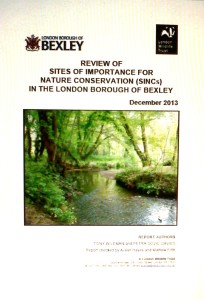Having recently been subject to considerable criticism over its vegetation management on sensitive wildlife sites, we would normally welcome Bexley Council’s apparent enthusiasm for some long grass, but not when it is (metaphorically) being used as a repository for the Sites of Importance for Nature Conservation review.

Kicked into the proverbial long grass …. Why has Bexley Council still not approved the 2013 SINC review report and recommendations over a year after publication?
That the Council commissioned a 10 year review, published in 2013, is laudable given the budgetary pressures that were by then already looming large, and this makes it all the harder to understand why it is that over a year later it has still not been adopted. The initial reason for the delay was that the Council had to get itself re-organised after the last Borough elections in early 2014, and get bedded into its new premises in the old Woolwich building. But this doesn’t account for the considerable extra time that has now elapsed.
The SINC review is a very important document, for whilst the sites listed do not have statutory protection, they are a material consideration in planning, and any ‘development’ proposed for such a location has to pass tests set out on the Council’s Local Development Framework, making it somewhat harder for the concrete merchants to destroy all or parts of them. The London Wildlife Trust, which did the official survey work, recommended that some new sites be added to the SINC list, and that others be promoted to a higher grade in the draft report produced back in December 2013. It also warned that some private sites had been degraded from a nature conservation perspective due to poor management, and even that Council-owned Danson Park should have some of its area removed from within the SINC boundary if the local authority kept using it for overflow car parking.
Bexley Natural Environment Forum Vice-chair Chris Rose said ‘We put a lot of effort into doing extra wildlife recording work on existing and potential SINCs and in making our data available to LWT and Bexley. This helped get two more sites listed, two others proposed for enlargement and one for promotion. We also made extensive and detailed comments on the draft recommendations so that site citations would be as accurate as possible. With top SINCs such as Mill Meadows and Erith Quarry currently the subject of ‘development’ applications, and the proposed strip of SINC land at Old Farm now slated for possible sell-off, it is extremely disturbing that Bexley Council has still not approved this document. The Council likes to claim that the ‘three pillars’ of economy, society and environment get equal billing in its planning processes, but yet again the reality is that the environment on which we all ultimately depend is coming a poor last in its thinking. No doubt the government would be quick to step in if Bexley was taking this long to deal with ‘development’ applications.’
The 2013 full, and 2011 partial SINC review documents can be downloaded at the foot of this page on the Council’s website:
